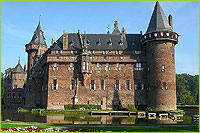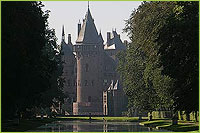| |
 |
|
Kasteel de Haar
The medieval residence De Haar was founded in the course of the fourteenth century,
on sediment deposits along a blind arm of the river Rhine. The first references to the
castle
date back to 1391. De Haar, however, is really special because - more than
100 years
ago now - it was entirely restored and partially rebuilt, resulting in a restoration unparalleled in Europe. This involves not only the architecture, but also the interior and
the gardens. Even the church and the village were involved in this project so that, without exaggeration, one could say it is a 'Gesamtkunstwerk' (integrated work of art): this is the creation of a unique, special, world in which all aspects of man's creative talents could
flourish.
Resurrection
De Haar already had its current, large pentagonal ground plan in the fifteenth century. It probably got this shape after the castle was destroyed in 1482 as a result of the quarrels between the Bishop and the city of Utrecht.
After this, the castle was rebuilt, but in the course of the eighteenth and nineteenth
century it fell into disrepair. The ruinous condition came to an end as from 1890, when
the young owner baron Etienne van Zuylen van Nijevelt decided to have the ancestral
castle restored in grand style. In 1892 the first activities at the castle started. In a few
years time an impressive castle would arise by incorporating the existing, still high-rising, fifteenth century walls. Nowadays the result can be viewed by anyone who wishes to visit .
Future restoration
All possible efforts have been invested in De Haar Castle. This remarkable monument
should be preserved for later generations. That is why in the near future a large and
costly restoration will be carried out. The medieval foundations need special attention,
since they have proven to be ill suited for the pressure of the building. During the
restoration the gardens and side buildings will be accessible.
|





